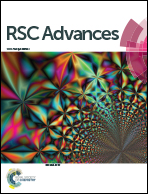Electronic pH switching of DNA triplex reactions†
Abstract
Electronic reversible switching of sequence-specific DNA interactions and reactions is an important operation for programming complex molecular and microscopic processes. While both quadruplex and triplex structures are suitable for moderate pH control (pH 5–7), we focus here on the large family of DNA sequences forming pH-sensitive triplex structures. These involve Hoogsteen and Watson–Crick base pairs in pyrimidine–purine–pyrimidine (Y:R:Y) motifs. We demonstrate electronically controlled local pH cycling, integrated into a microfluidic chip, which induces DNA hybridization switching in these triplex complexes. We also show that pH switching can be used to control rapid DNA ligation in double strand templated triplex structures using disulphide linkages. Switching between DNA complexes induced by pH is first characterized using capillary gel electrophoresis before employing local microelectrodes. Robust pH cycling is achieved over a moderate pH range (4–8), by voltage-biased gold microelectrodes immersed in quinhydrone redox systems, both in solution and immobilized on the surface, and is monitored via fluorescence ratio imaging with SNARF-4F. The resulting switching of DNA structures (reversible triplex to duplex, triplex-based DNA ligation) based on a hairpin template is spatially monitored by dye–quencher fluorescence. The integration of electronically controlled pH cycling into a microfluidic reactor allows both local patterning of pH and the maintenance of constant ionic strength over many cycles.


 Please wait while we load your content...
Please wait while we load your content...